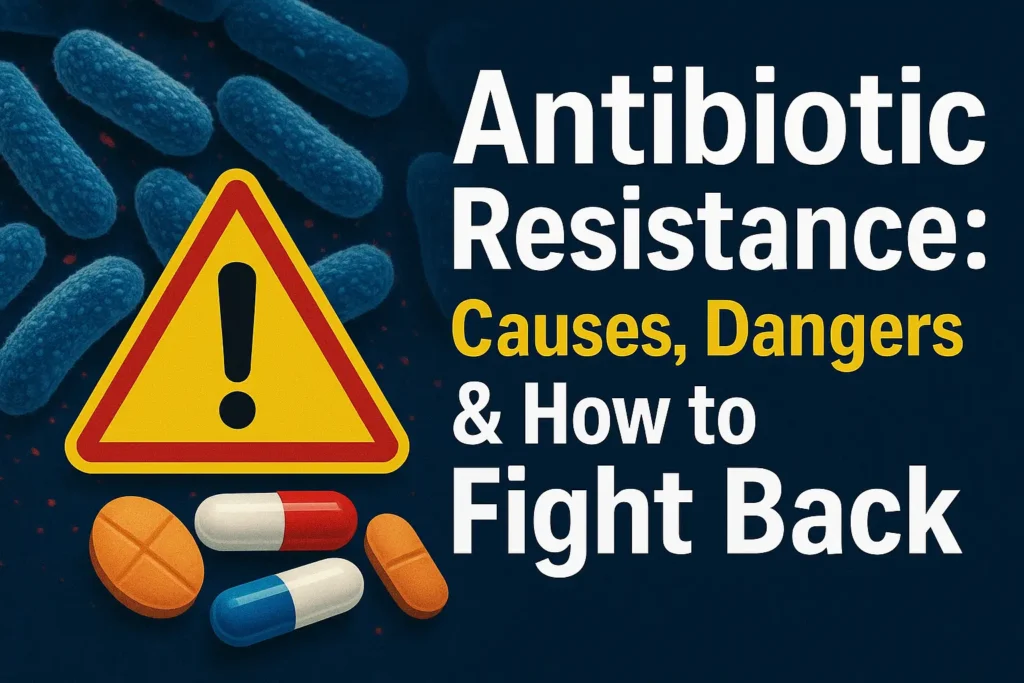
What if your next common infection no longer had a cure? That’s the terrifying reality we could face as antibiotic resistance continues to rise. Before we dig deep, let’s first discuss what antibiotic resistance is.
“Antibiotic Resistance is the ability of bacteria to carry out a genetic mutation and oppose the effect of antibiotics“
It makes some bacterial infections tricky to treat. Misuse and excessive use result in antibiotic resistance.
This issue can be solved if one understands the root cause, dangers and preventions of such antibiotic resistance.
All About Antibiotic Resistance
Antibiotic resistance can also be called antimicrobial resistance. Which is not limited to bacteria only but extends to other microbes such as: Fungi and Parasites
What happens is that when any antibiotic is administered, it doesn’t show any effect on you after a few doses.
Why not? It’s not your body that has become resistant. It is the bacteria that have evolved and developed immunity against it. Bacteria get stronger with time. Infections also require longer time and are more difficult to treat.
As the result of the delay, patients may feel some symptoms like:
- Higher risk of severe, prolonged illness or death.
- Serious drug side effects.
- Extended hospital stays.
- Additional doctor appointments.
- Higher health expenses.
What Causes Antibiotic Resistance?
Antibiotic resistance is caused by overuse of antibiotics. Bacteria learn to survive when they come in contact with an environment very frequently, as a survival instinct. This makes infections harder to treat.
Overuse of Antibiotics in Humans
Main causes of Antibiotic resistance may include:
- These drugs do not work on viruses. But they are still given or taken. This is a major cause of resistance.
- Some people do not complete the antibiotic course. Bacteria get familiar with the drug and become immune to it.
- Easy access to antibiotics without prescriptions also leads to overuse.
Overuse of Antibiotics in Agriculture
Antibiotics are being used on animals to help them grow faster. They are also used to keep animals healthy.
This overuse of antibiotics leads to drug-resistant bacteria. These bacteria spread very easily if ingested or come in contact with anyone.
Poor Infection Control
Weak Infection control means bacteria can spread easily between patients. If these bacteria are resistant then it can be a bigger problem.
Clean hands, clean tools, and proper care help reduce the spread. Without this, resistant bacteria will continue to grow and spread.
Lack of New Antibiotics
We are in lack of new antimicrobials in the medicine market. It costs a lot and takes time to make the drug, so the companies are not making new antibiotics. It costs a lot and takes time.
Because of this, we are still using older drugs. Some of these do not work well against new resistant bacteria. Without new options, treating infections becomes harder.
Who Is Most at Risk of Antibiotic-Resistant Infections?
People who are at high risks of resistant infections (MRSA and CRE) caused by drug-resistant bacteria are:
People at Higher Risk:
- Hospital patients
- May have weak immune systems
- Often have open wounds or surgical cuts
- Use devices like catheters or ventilators
- Older adults
- Naturally have weaker immune systems
- Often have other health problems
- People in nursing homes or long-term care
- Share spaces and medical equipment
- Have frequent contact with staff and other residents
- People who use antibiotics often
- Repeated use allows bacteria to adapt and become stronger
- Repeated use allows bacteria to adapt and become stronger
- Healthcare workers
- May carry and spread resistant bacteria without symptoms
- Need strong hygiene practices to prevent spread.
Which Infections Are Most Affected by Resistance?
| Infection Type | Effect of Antibiotic Resistance | Examples of Drug-Resistant Bacteria |
| UTIs | Harder to treat and may spread to kidneys. | E. coli (resistant strains) |
| Pneumonia | Needs stronger or multiple antibiotics. | Streptococcus pneumoniae |
| Sepsis | Delays treatment and raises risk of death. | Klebsiella, CRE |
| STIs (like Gonorrhea) | Some strains resist almost all treatments. | Neisseria gonorrhoeae |
| Skin Infections | Simple wounds may turn serious. | MRSA |
What Is an Antibiotic-Resistant UTI?
treatment using normal antibiotics.
UTI is commonly caused by E. Coli. Bacteria have the tendency to mutate and they can change themselves struturally, functionally and genetically. These changes make the bacteria overcome antibiotics by killing them
For example, some forms of E. Coli make enzymes called extended-spectrum beta-lactamases (ESBLs). The enzymes degrade and kill antibiotics.
When this happens antibiotics no longer affect bacteria the same way. And it can end up affecting the kidney and making problem worse.
What Are Superbugs and Why Are They Dangerous?
Superbugs are a very challenging type of antibiotic-resistant bacteria to treat. That no longer respond to commonly used antibiotics.
Infection with superbugs can be serious and challenging to treat. Traditional examples include MRSA and CRE. The bugs normally propagate in hospitals, but also occur in the general population.
Superbugs do not respond to conventional medicine. This prolongs infection and occasionally makes it deadly.
Superbugs are fatal in the sense that they cannot be cured using lots of antibiotics. This is to say that regular medication cannot help heal them.
Superbug infections may spread very quickly and progress inside the body. If left untreated the infection can get fatal.
Which Antibiotic-Resistant Bacteria Are the Most Deadly?
Following are the details of Antibiotic-Resistant Bacteria that are deadly:
| Bacteria | Why It’s Dangerous | Notes |
| MRSA | A superbug that resists many antibiotics. Causes severe skin and blood infections. | One of the most common drug-resistant bacteria. |
| CRE | Resistant to almost all antibiotics. Can cause deadly infections in the bloodstream and lungs. | Listed among WHO priority pathogens. |
| Drug-resistant Mycobacterium tuberculosis | Causes tuberculosis that is hard to cure. Requires long and intense treatment. | Also on the WHO priority pathogens list. |
| Drug-resistant Neisseria gonorrhoeae | Causes gonorrhea that is hard to treat due to resistance. | A growing concern worldwide. |
| Drug-resistant Klebsiella pneumoniae | Can cause pneumonia and bloodstream infections. Often resistant to many antibiotics. | On the WHO priority pathogens list. |
Conclusion: What You Can Do Today
Antibiotic resistance is basically the capability of a microbe to protect itself from the action of any antibiotic.
This is also called Microbial resistance. Overuse or misuse of antibiotics can cause this resistance. This can, in severe situation, result in death.
UTIs, pneumonia, and sepsis are resistant infections which are more difficult to treat and more probable to result in longer illness or adverse outcomes.
Dangerous superbugs like MRSA and CRE make infections tougher to fight.
You can help stop antibiotic resistance. Here’s how:
- Always take antibiotics when prescribed by your doctor.
- Complete your prescribed dosage.
- Wash your hands often and follow all of the steps..
- Get your vaccination done and updated with a booster dose.
- Practice good infection control at home and work.
Doctors have started to use combination therapy, which uses two or more drugs to fight bacteria. Every small action helps. Let’s slow down resistance together.


